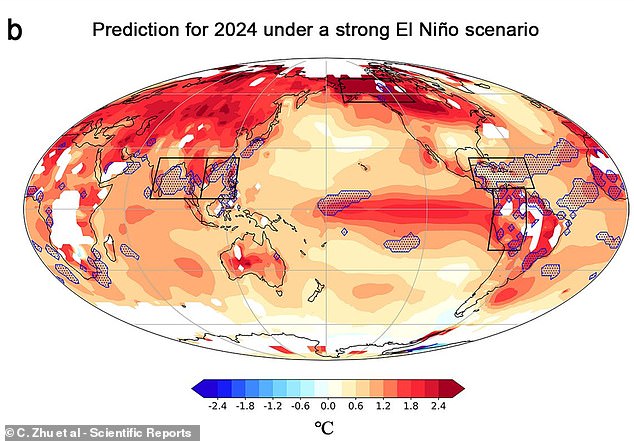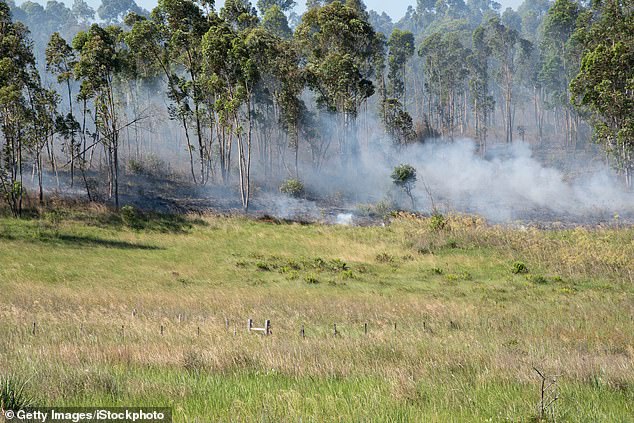Terrifying maps reveal the three parts of the world that will experience record temperatures this year thanks to El Niño
Last year may have been the hottest on record, but a new study has warned the worst is yet to come.
Frightening maps have revealed the areas most likely to be hit by record-breaking heat this year thanks to El Niño – an unusual warming of sea surface temperatures that happens once every few years.
The Bay of Bengal, the Philippines and the Caribbean Sea are all likely to be hit by record heat waves before June this year, according to experts from the Chinese Academy of Meteorological Sciences.
But that doesn’t mean people in other areas won’t be affected.
The study also warns that there is a 90 percent chance that record-breaking global average surface temperatures will occur during the same period.
Frightening maps have revealed the areas most likely to be hit by record-breaking heat this year thanks to El Niño. On this map, the dark red areas show greater variation above the average temperature
The El Niño-Southern Oscillation, as it is technically called, is one of the leading causes of climate differences around the world.
The warmer waters, mainly centered in the tropical Pacific Ocean, increase the annual global average surface temperature, changing weather worldwide.
And as the world experiences even small increases in average temperatures, some regions see significant increases during local extreme heat events.
This effect is so pronounced that the researchers write in the article, published in Scientific reportsthat it is ‘the strongest year-to-year determinant of climate variability on the planet.’
To find out how El Niño affects local temperature peaks, the researchers created a model that could estimate how hot areas would become during an El Niño year.
This model revealed the difference between average regional temperatures between July 2023 and June 2024 and the 1951-1980 baseline.

This map shows the variation from the average in a strong El Niño scenario. In this case, the areas of Alaska and the Amazon will also see record-breaking temperature spikes this year (record-breaking areas shown with blue dots)
The researchers found that in the moderate scenario, the Bay of Bengal, the Philippines and the Caribbean Sea will all experience record highs of more than 1°C above average.
However, in a strong El Niño scenario, the researchers predict that the effects will be even greater.
If this continues, areas in Alaska, the Amazon and the South China Sea will all reach record temperatures as well.
In Alaska, these highs will be as much as 2.4°C above the 1951-1980 average.

If Alaska is hit by an extreme temperature event, researchers warn there is a risk that glaciers like the Mendenhall Glacier (pictured) will melt at a much faster rate
At a global level, the researchers found that even in the moderate scenario, there was a 90 percent chance that the global mean surface temperature (GSMT) would break the historical record this year.
Under a moderate El Niño, the GSMT will be between 1.03 and 1.10 °C above average, while a strong event will see temperatures 1.9 to 2.16 °F (1.06 to 1.20 °C) will rise above that average. .
The researchers write: ‘Strong El Niño events could cause GMST to rise rapidly, potentially exceeding the desired ambitious 1.5°C target of the Paris Agreement for a short period.’
Worryingly, these models also suggest that the world may be at greater risk of extreme weather events.
In Alaska, the researchers note that there is a risk of glaciers or permafrost melting, which could cause sea levels to rise or warming to spiral out of control.

In the Amazon, the model predicts there will be record temperatures that could trigger a drought-induced wildfire like the one in Brazil last year (photo)
In the Amazon, meanwhile, extreme heat events are creating an increased risk of drought-induced wildfires, similar to the wildfires that destroyed large swathes of rainforest in 2019.
The researchers write: ‘This impending heat increases the risk of year-round marine heat waves and escalates the threat of wildfires and other negative impacts in Alaska and the Amazon Basin.’
Hotter seas also bring a high risk of tropical cyclones that can be extremely destructive in low-lying coastal areas.
Previous studies have suggested that rising temperatures due to climate change could trigger a wave of ‘mega-hurricanes’ with winds of up to 310 km/h.
Unfortunately, the model also suggests that these coastal areas will be the most susceptible to extreme heat in the coming year.

